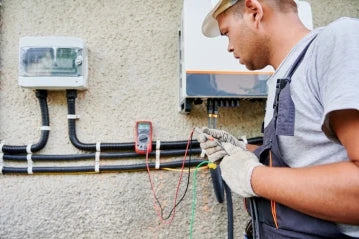
As solar energy gains popularity as a sustainable and cost-effective alternative to traditional power sources, understanding the technology behind it becomes essential for potential buyers. Inverter chargers play a crucial role in harnessing solar energy efficiently and storing it in batteries. In this article, we will explore the fascinating process of how an inverter charger charges a battery, shedding light on the key components and mechanisms involved.
I. The Role of Inverter Chargers in Solar Energy Systems
Inverter chargers act as the backbone of solar energy systems, converting direct current (DC) electricity produced by solar panels into alternating current (AC) electricity suitable for use in homes, offices, or other applications. They also enable the charging and maintenance of batteries, ensuring a continuous and reliable power supply.
II. Key Components of an Inverter Charger
A. Inverter
The inverter is the primary component responsible for converting DC electricity from the solar panels or batteries into AC electricity. It regulates the voltage and frequency of the AC power, ensuring compatibility with standard electrical devices and appliances.
B. Charger
The charger component of an inverter charger is responsible for replenishing the battery bank's energy. It converts AC electricity from the grid or a generator into DC power and supplies it to the batteries. The charger adjusts the charging voltage and current based on the battery's state of charge (SOC) and chemistry to optimize the charging process.
C. Transfer Switch
The transfer switch is a crucial safety feature of an inverter charger. It automatically switches between the grid power and battery power in the event of a power outage or when the solar panels cannot generate enough electricity to meet the demand. This seamless transition ensures uninterrupted power supply and protects sensitive electronic devices from power fluctuations.
III. How an Inverter Charger Charges a Battery
A. Bulk Charging
During the initial phase of battery charging, the inverter charger operates in the bulk charging mode. It supplies a high current at a constant voltage, allowing the battery to charge rapidly. The charger monitors the battery's voltage and adjusts the charging current accordingly. As the battery's SOC increases, the charging current gradually decreases.
B. Absorption Charging
Once the battery reaches a specific voltage threshold, the inverter charger switches to absorption charging mode. In this phase, the charger maintains a constant voltage while gradually reducing the charging current. The battery continues to charge, albeit at a slower pace. This stage ensures that the battery reaches its full capacity without overcharging.
C. Float Charging
After the battery has been sufficiently charged, the inverter charger enters float charging mode. The charger supplies a lower voltage, often referred to as the "float voltage," to maintain the battery's charge and compensate for any self-discharge. Float charging is necessary to keep the battery ready for use and prolong its lifespan.
IV. Monitoring and Protection Features
Modern inverter chargers incorporate advanced monitoring and protection features to ensure the safety and longevity of the battery system. These features include:
- Battery temperature compensation: Adjusts the charging voltage based on the battery's temperature to prevent overcharging or undercharging.
- Overcurrent protection: Prevents excessive current flow, protecting the battery from damage.
- Overvoltage and undervoltage protection: Guards against voltage spikes and drops, preserving the battery's health.
- Battery equalization: Balances the charge among individual battery cells, ensuring uniform capacity and longevity.
Conclusion
Inverter chargers play a vital role in enabling solar energy systems to efficiently charge and maintain batteries. By converting DC electricity into AC power, they make solar energy compatible with our everyday appliances. Understanding the different charging modes and protection features helps users optimize their battery performance and extend their lifespan. As you embark on your solar energy journey, selecting a reliable inverter charger that suits your needs is crucial for a seamless and sustainable solar experience.
Remember, a well-designed and properly installed solar energy system, complete with an efficient inverter charger, can significantly reduce your carbon footprint while providing reliable power for your home or business.


0 comments